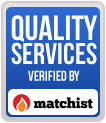Like all Internet users, you’ve encountered a few bad websites in your days of browsing the web. No, not just bad design. It’s much more than that. The key question for small business owners is: what qualities must your website have to be viewed as a quality site? This article gives you the answer in 10 easy parts.
1. Who are you?
If someone finds your website, they should be able to easily access information about who you are. Your name should be clearly stated with a list of the services or products you offer. Don’t worry with putting this on an About Me page. Place it right on the homepage. The less investigative work your visitors have to do, the better. If you can catch a visitor’s attention with a clear description, you can encourage them to stay awhile.
2. Plain and simple
Your user name is important. Much like your brand, it should be easy to remember and easy to type in the address bar. Don’t make things complicated. And, please, avoid using dashes and numbers in your domain name.
Which domain should you use? .com, .co, .us, .net? There are so many to choose from. Don’t let the list of options blur your focus. For businesses, users are accustomed to the .com domain. Typing it in is almost automatic. If you’re an organization or non-profit, your users will know this and type .org.
3. A user friendly site map
Don’t leave your visitors feeling as if they’re on a scavenger hunt. Make links to important pages clear, and offer the option of visiting your site map. Many successful sites use dropdowns in their navigation menu to give visitors the ability to see content under each heading from any page.
4. Contact us
Nothing is more frustrating than wanting to contact a business and failing to locate contact information. Don’t let this simple task be the reason you lose customers to the competition.
Place clear contact information on each page of your site; the best placement is the top left or top right corner. This can easily be done using a header or footer with the information.
Include phone number(s), email addresses, and/ or your physical address. A link to your location on Google maps is great for visitors accessing your site on a mobile device. A contact form is an option, but may frustrate the visitor who wants immediate gratification.
Variety is best when giving contact information. This puts the choice of contact method in the hands of potential customers.
5. Testimonials
We all feel better about doing business with a company who has pleased customers before us. This is the reasoning behind Amazon’s customer reviews. And, it works!
Customer testimonials build trust, make your products more tangible, and help consumers know if your product or service is right for them.
6. Instructions
What is it you want your site visitors to do? Tell them, nicely. They may not even know of the opportunity until you tell them. Some examples include: “Call now for a free quote,” “Sign up for exclusive online offers,” “Click here to add products to your shopping cart.”
Making this text more noticeable with color, highlights, bold font, or special buttons is another way to draw attention to the desired task.
7. Optimize with keywords
You’ve heard of SEO, and you know that it helps people to find your site. But, like a shovel, SEO can’t be effective unless you use it. The good news is that there are no magic wands, chants, or secret passwords to rank well among the top search engines.
It’s as simple as using keywords throughout your site content, placing the keywords in your links, and correctly naming your page titles and URLS. Making use of images and videos is also a plus.
8. Content that’s fresh and good
Freshness and quality are key to website content. First of all, your content often serves as a first impression for potential customers. Second, content provides the meat of what your visitors seek. Give them original, well-written content that’s valuable to their needs, and you’ll keep them coming back.
Fresh content and SEO go hand in hand. To utilize both, consider adding a regularly updated blog to your site. Not only will this help with content, it provides more places to embed those prized keywords.
9. Secure hosting
How horrid to have spent a great deal of time and money on your site only to have the information stolen! Not only could it cost you more of your investment, it could cost you customers. You must have a secure hosting company who knows how to keep your information safe from hackers while maintaining a high percentage of uptime.
10. Simple and strong design
Web users are the world’s best at scanning and moving on. Your web design and style must be user-friendly while providing content that encourages readers to slow down. How is this task accomplished?
- Break the content into short, focused paragraphs
- Provide headers for each section
- Use bullet points
- Highlight or bold important phrases or words
- Go with simple and basic for your colors and font




